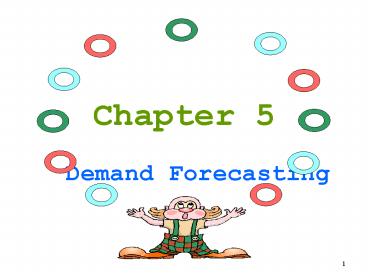Demand Forecasting - PowerPoint PPT Presentation
1 / 28
Title: Demand Forecasting
1
Chapter 5
- Demand Forecasting
2
- 1.Importance of Forecasting
- Helps planning for long-term growth
- Helps in gauging the economic activity (auto
sales, new home sales, electricity demand) - Reduces risk and uncertainty in managerial
decisions.
3
Types of Forecasts
- Qualitative Forecasts- Forecasts based on the
survey of experienced managers - Quantitative Forecasts- Forecasts based on
statistical analysis (Trend projections)
4
- 2.Qualitative Forecasts
- Surveys and opinion polls
- executives and Sales persons. They are used to
- Make short-term forecasts when quantitative data
are not available - Supplement quantitative forecasts
- Forecast demand for new products for which data
do not exist.
5
- 2Qualitative Forecasts Examples
- Surveys of business executives plant and
equipment expenditure plans - Surveys of plans for inventory change and
expectations - Surveys of consumers expenditure plans
6
- Opinion polls
- -Executive polling
- -Sales force polling
- -Consumer intention polling
7
- 4.Quantitative Forecast Methods
- Time Series Analysis - use of past values of an
economic variable in order to predict its future
value. - Trend Projections (linear trend, growth rate
trend).
8
Types of Time Series Data Fluctuations
- Secular trend-long-run upward moments or downward
movements (population size, evolving tastes) - Cyclical fluctuations-fashion, political
elections, housing industry experiencing decline
and rebounding) - Seasonal Fluctuations- Housing starts, Hickory
Farm sales Nov-January, Christmas sales
9
- Irregular or random fluctuations variation in
data series due to unique events such as war,
natural disaster, and strikes.
10
- 6. Trend Projection
- Extension of past changes in time series data
into the future (sales, interest rate, stock
value forecasting) - a)Constant amount of change or growth
- Sales f(time trend)
- St a bt ? constant amount
- of growth
11
- b) Exponential growth function
- St So(1g)t constant percentage growth
(exponential growth)
12
- 6a. Linear Trend Projection
13
- Demand for Electricity in KWH(million)
- Year St t Year St t
- 92-1 11 1 94-1 14 9
- -2 15 2 -2 18 10
- -3 12 3 -3 15 11
- -4 14 4 -4 17 12
- 93-1 12 5 95-1 15 13
- -2 17 6 -2 20 14
- -3 13 7 -3 16 15
- -4 16 8 -4 19 16
14
- St 11.90.394t R2.5
- S17 11.9 .394(17) 18.60
- S18 11.9 .394(18) 18.99
- S19 11.9 .394(19) 19.39
- S20 11.9 .394(20) 19.78
15
- 6b. Exponential Growth Projection
- Model St S0 ( 1 g)t
- ln St lnS0 t ln(1 g)
- Year lnSt t
- 92.1 2.398 1
- . . .
- . . .
- . . .
- 95.4 2.944 16
16
- ln St 2.49 .026t
- Taking the antilog of both sides yields,
- St 12.06(1.026)t R2 .5
- S17 12.06(1.026)17 18.76
- S18 12.06(1.026)18 19.14
- S19 12.06(1.026)19 19.64
- S20 12.06(1.026)20 20.15
17
- Notice that forecasts based on linear trend model
tend to be less accurate the further one
forecasts into the future.
18
- 7.Methods of Incorporating Seasonal Variation
- Ratio to trend method
- Group the data by quarters
- Get a forecasted value for each quarter by using
the trend model - Calculate the actual/forecast ratio for each
season or each month. - Find the average of the actual/forecast ratio for
each season over the entire period of the study.
19
- b. The dummy variable method
- Multiply each unadjusted forecasted value of the
economic variable by its corresponding seasonal
adjusting factor. - Include n-1 dummy variables in the trend equation
and run the regression.
20
- Time-Series Growth Patterns
Y
Y
Y
Time(t)
Time(t)
Time(t)
(b)Exponential growth trend
(c)Declining rate of growth trend
(a)Linear trend
21
- 8.Some shortcomings of Time Series Analysis
- Assumes that past behavior will be repeated in
the future - Cannot forecast turning points
- Does not examine the underlying causes of
fluctuations in economic variables.
22
- 9.Smoothing Techniques (Irregular Time Series
Data) - Refer to the methods of predicting future values
of a time series on the basis of an average of
its past values only - They are used when the data show irregular
variation (random).
23
- Moving Averages
- Help to generate acceptable future period value
of a variable when the time series are subject to
random fluctuations. - -See, Table 5-5 in the handout
- 3-quarter vs 5-quarter Moving Average Forecasts
and Comparison - Objective Forecast 13th quarter value,
- given time series data for the previous 12
quarters
24
- Choose the appropriate period based on the
lowest RMSE. - RMSE
- At actual value of the time series in period
t. - Ft the forecasted value of the time series in
period t. - Problem Gives equal weight to
- each period
25
- b. Exponential smoothing
- - a smoothing technique in which the forecast
for period t1 is a weighted average of the
actual (At)and forecasted values(Ft) of the time
series in period t.
26
- Ft1 wAt (1-w)Ft
- where Ft1 the forecast of F in period t 1.
- w the weight assigned to the
- actual value of the time
- series, 0ltwlt1.
- 1-w the weight assigned to
- the forecasted value of
- the time series.
27
- 10. Using Econometric Models to Forecast
- Advantages
- Seek to explain the economic phenomenon being
forecasted- i.e. enables mgt to assess the impact
of changes in policies (price, Ad) - Predict the direction and magnitude of change
28
- Models can be modified based on the comparison of
actual and forecast value. - Examples
- Comment The above advantages have to be weighed
against the difficulties of getting the forecast
values of each of the explanatory variables.































